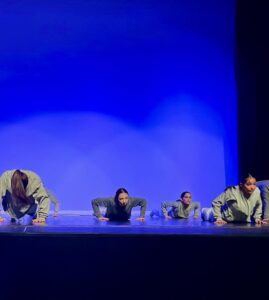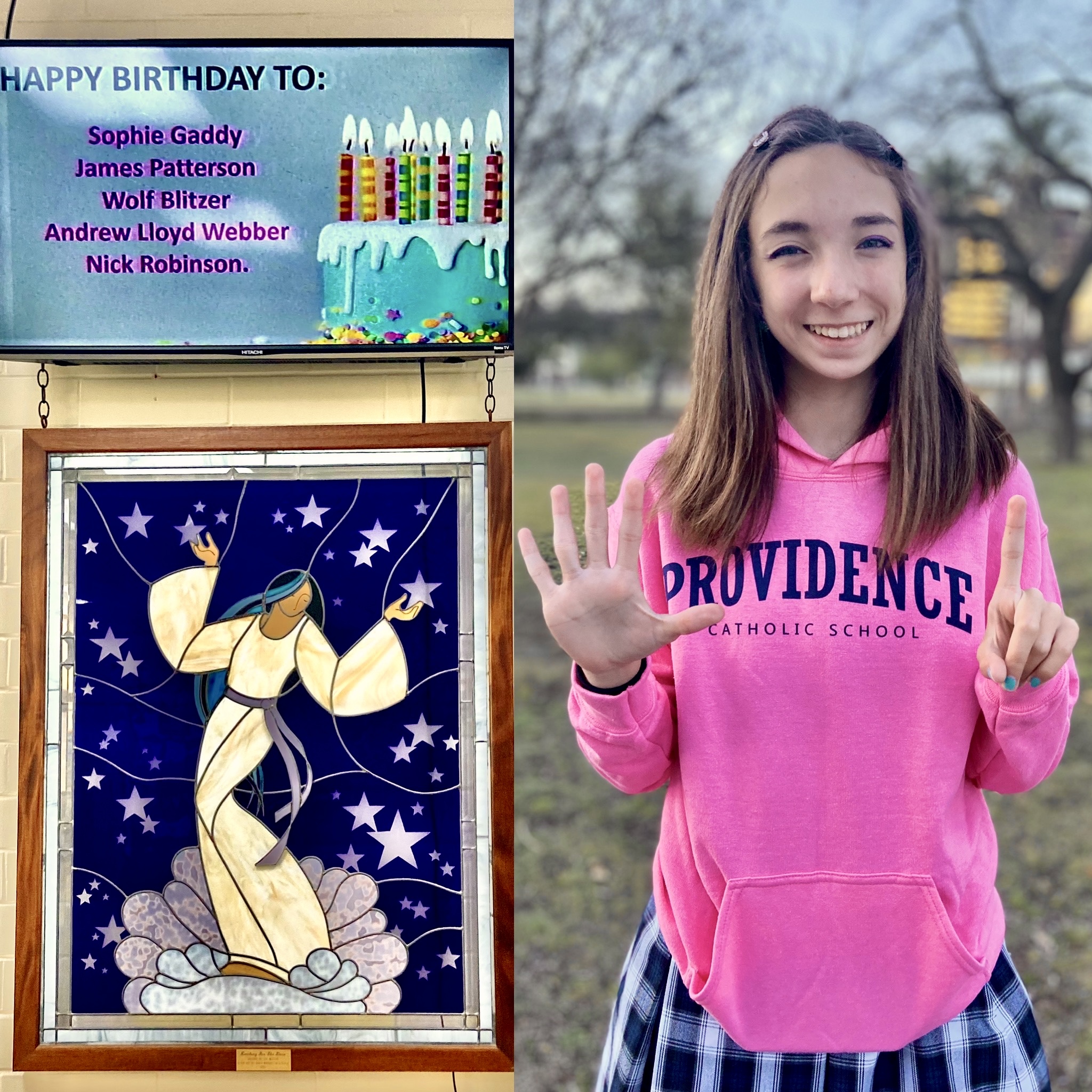Sophie Gaddy’s deafness doesn’t stop her from dancing
By Cam Ellis
Sophie Gaddy had never been to New York City before. It’s a bit of a hike from where she lives in San Antonio, Texas, but when she got the chance to take a trip east with her school’s drama department, she jumped at the opportunity.
“On the first day I was like, wow, there’s a lot of people,” she said. “Like, no one really cares about what anyone else is doing. They all just have a certain goal in mind, like to get there. So by the fifth day, I was like a true New Yorker.”
Talk to Sophie for 15 minutes and you’ll see why she relates so well to that certain restlessness and ambition that people have come to associate with the Big Apple’s locals. On any given day, the 10th grader is involved in a handful of activities that are as impressive as they are diverse. Whether it’s drama, dancing, track, or volleyball, Sophie’s dedication to filling her hours with her passions is an inspiration to all those who live with hearing disabilities, like she does. It can also stress her mom, Janeth Gaddy, out.

“I just see how hard she works,” Janeth said. “And nobody really knows how much harder than everyone else she has to work. For example, in her classroom, she compensates so well for her hearing loss that nobody really knows that she has a hearing loss.
“All the things that you and I take for granted – like how we never have to change our batteries. She has to have batteries. She has to make sure that she is well prepared to attend a class. If her electronics or her equipment fails her that day, she’s in so much trouble. So the fact that she seems to navigate a hearing world so much easier than I probably ever could – it just amazes me every day.”
Sophie was born with bilateral microtia and atresia. Essentially, her ears – both externally and internally – didn’t physically develop the way that most do. Her case is especially rare: only around 10 percent of microtia is bilateral – most cases only affect one ear. Because of her microtia, she doesn’t wear the more commonly-known, behind-the-ear hearing aid. Instead, at 10 years old, Sophie had surgery to implant bone-anchored abutments. The procedure improved her hearing by 25 decibels; for context, according to Yale University’s decibel level comparison chart, that’s the difference between a normal conversation and city traffic.
“I actually never really cared if she had the surgery or not as long as she could hear us,” Janeth said. “But knowing that she was going to be able to hear so much better, and not to have to wear that headband that she used to wear when she was little? I think it added to her confidence. And the fact that she could hear so much better was kind of a no-brainer after that.”
 Now Sophie’s hearing is better than most people around her realize. Equipped with exceptional hearing – on the days she remembers to pack her batteries, at least – Sophie now spends much of her free time dancing. Jazz, contemporary, and hip-hop are all styles she’s recently been into – she loves the high energy music.
Now Sophie’s hearing is better than most people around her realize. Equipped with exceptional hearing – on the days she remembers to pack her batteries, at least – Sophie now spends much of her free time dancing. Jazz, contemporary, and hip-hop are all styles she’s recently been into – she loves the high energy music.
Having better hearing than others realize is oddly an advantage, she admitted, that comes in handy quite a bit.
“A lot of people don’t realize that I can actually hear,” she said with a wry smile. “Like, they know I have hearing aids, but they don’t actually expect it to work as well as it does. So I have an advantage in most places, because people will say something and I’ll be like, I can hear that. Like, I can hear everything you’re saying. So it’s definitely interesting in social situations.”
Música para sus oídos y sus pies
A Sophie Gaddy la sordera no le impide bailar
Por Cam Ellis
Sophie Gaddy no había estado antes en Nueva York. Se encuentra un poco lejos de donde vive, en San Antonio (Texas), pero, cuando tuvo la oportunidad de realizar un viaje al este del país con el departamento de arte dramático de su escuela, no la desaprovechó.
«El primer día me dije: vaya, hay mucha gente», comenta. «A nadie le importa lo que hacen los demás. Todos tienen un objetivo en mente: llegar a su destino. Así que, al quinto día, ya me sentía una auténtica neoyorquina».
Cualquier persona que converse con Sophie durante 15 minutos se dará cuenta de por qué se identifica tanto con esa inquietud y ambición que la gente asocia con los habitantes de la Gran Manzana. En un día cualquiera, esta alumna de secundaria realiza un gran número de actividades tan sorprendentes como diversas. Ya sea teatro, baile, atletismo o voleibol, la dedicación de Sophie a llenar sus horas con actividades que le apasionan sirve de inspiración a todas las personas con discapacidades auditivas, como es su caso. También puede estresar a su madre, Janeth Gaddy.
«Solo veo lo mucho que trabaja», dice Janeth. «Y nadie sabe verdaderamente todo lo que se tiene que esforzar. Por ejemplo, en el aula, compensa tan bien su pérdida auditiva que nadie sabe realmente que la tiene».

«Son muchas las cosas que todos damos por sentadas, como no preocuparnos nunca de cambiar pilas. Sophie tiene que preocuparse de llevarlas porque debe estar bien preparada para asistir a las clases. Si le falla la tecnología o el equipo, ese día tendrá muchos problemas. La verdad es que el hecho de que se desenvuelva en un mundo auditivo mucho más fácilmente de lo que yo probablemente nunca podría, no deja de asombrarme todos los días».
Sophie nació con microtia y atresia bilaterales. Básicamente, sus oídos, tanto externos como internos, no se desarrollaron físicamente como los de la mayoría de las personas. Su caso es especialmente raro: solo un 10 % de los casos de microtia son bilaterales, dado que en su mayoría solo afecta a un oído. En cuanto a la microtia, no utiliza el audífono retroauricular más común, ya que, a los 10 años, se sometió a una intervención quirúrgica de implantación de pilares con anclaje óseo. La intervención mejoró su audición en 25 decibelios; según la tabla comparativa de niveles de decibelios de la Universidad de Yale, esa es la diferencia entre una conversación normal y el tráfico de la ciudad.
«En realidad, nunca me importó si se operaba o no, siempre que pudiera oírnos», dice Janeth. «Sin embargo, un punto a favor fue que oiría mucho mejor y que no tendría que llevar ninguna cinta en la cabeza. Creo que sirvió para que aumentase su propia confianza. Y el hecho de que pudiera oír mucho mejor fue determinante».
Actualmente, la audición de Sophie es mejor de lo que piensa la mayoría de la gente. Dotada de una audición excepcional, al menos en los días que se acuerda de llevar las pilas, Sophie dedica al baile una gran parte de su tiempo libre. Últimamente se ha aficionado al jazz, al baile contemporáneo y al hip-hop; le encanta la música con una gran energía.
Admite que tener una audición mejor de lo que otras personas creen es una ventaja que le resulta bastante útil.
 «Mucha gente no se da cuenta de que realmente puedo oír», comenta con una sonrisa traviesa. «Saben que llevo audífonos, pero no esperan que funcionen tan bien. En muchos lugares es una gran ventaja porque puedo oír lo que dicen otras personas. Puedo oír todo lo que dicen y es, sin duda, interesante en algunas situaciones sociales» .
«Mucha gente no se da cuenta de que realmente puedo oír», comenta con una sonrisa traviesa. «Saben que llevo audífonos, pero no esperan que funcionen tan bien. En muchos lugares es una gran ventaja porque puedo oír lo que dicen otras personas. Puedo oír todo lo que dicen y es, sin duda, interesante en algunas situaciones sociales» .

